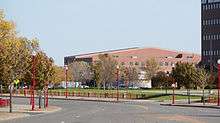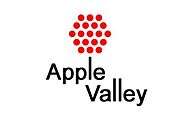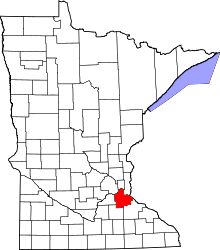Apple Valley, Minnesota
| Apple Valley, Minnesota | ||
|---|---|---|
| City | ||
|
Apple Valley during the autumn of 2006 | ||
| ||
| Motto: "Plant, Grow, Prosper"[1] | ||
 Location of the city of Apple Valley within Dakota County, Minnesota | ||
| Coordinates: 44°43′55″N 93°13′03″W / 44.73194°N 93.21750°WCoordinates: 44°43′55″N 93°13′03″W / 44.73194°N 93.21750°W | ||
| Country | United States | |
| State | Minnesota | |
| County | Dakota | |
| Government | ||
| • Mayor | Mary Hamann-Roland | |
| Area[2] | ||
| • City | 17.57 sq mi (45.51 km2) | |
| • Land | 16.86 sq mi (43.67 km2) | |
| • Water | 0.71 sq mi (1.84 km2) | |
| Elevation | 955 ft (289 m) | |
| Population (2010)[3] | ||
| • City | 49,084 | |
| • Estimate (2015)[4] | 51,221 | |
| • Rank | US: 743rd MN: 18th | |
| • Density | 2,911.3/sq mi (1,124.1/km2) | |
| • Metro | 3,524,583 (US: 16th) | |
| • Demonym | Valleyian | |
| Time zone | CST (UTC-6) | |
| • Summer (DST) | CDT (UTC-5) | |
| ZIP code | 55124 | |
| Area code(s) | 952 | |
| FIPS code | 27-01900 | |
| GNIS feature ID | 0639415[5] | |
| Website | ci.apple-valley.mn.us | |
Apple Valley is a city in northwestern Dakota County in the State of Minnesota, and a suburb of the Twin Cities. As of the 2010 census, the city's population was 49,084,[6] making it the 18th most populous city in Minnesota. In 2013, Money Magazine named Apple Valley the 17th best place to live in the United States, up from 20th in 2010, 24th in 2008 and 28th in 2007.[7]
History
Apple Valley was founded in 1969, and was previously named Lebanon Township.[8] Orin Thompson, a real estate developer, was responsible for the city's early development. He contracted a company to determine where the next growth in the Twin Cities would be. It was one-half of a mile from County Road 42 and Cedar Avenue. Thompson bought the first houses and streets from the Brobacks, who built the city's first four houses. The firm that selected this area was in Apple Valley, California, so Thompson took that name for the development. An alternate explanation for the name change exists, however. According to local developer Henry Broback, Lebanon Township was renamed Apple Valley because "...when you drive east on (County Road) 42 and turn to enter Lebanon, it reminded them of Apple Valley, California, which was a nice community."[9][10]
Geography

According to the United States Census Bureau, the city has a total area of 17.57 square miles (45.51 km2), of which 16.86 square miles (43.67 km2) is land and 0.71 square miles (1.84 km2) is water.[2] The city's geography is rolling, with elevation from the lowest to the highest points in the city varying by a hundred feet or more. The downtown area and its adjacent residential district (which formed the original core of the city when it was incorporated) are in a shallow valley. A lot of the area around Apple Valley is still undeveloped, or contains large quarries.
Demographics
| Historical population | |||
|---|---|---|---|
| Census | Pop. | %± | |
| 1970 | 8,502 | — | |
| 1980 | 21,818 | 156.6% | |
| 1990 | 34,598 | 58.6% | |
| 2000 | 45,527 | 31.6% | |
| 2010 | 49,084 | 7.8% | |
| Est. 2015 | 51,221 | [11] | 4.4% |
| U.S. Decennial Census[12] 2015 Estimate[4] | |||
Apple Valley is in Minnesota's 2nd congressional district, represented by John Kline, a Republican. Apple Valley is represented in the Minnesota Legislature by State Senator Greg Clausen (Democrat, District 57), Representative Tara Mack (Republican, District 57A), and Representative Anna Wills (Republican, District 57B).
2010 census
As of the census[3] of 2010, there were 49,084 people, 18,875 households, and 13,382 families residing in the city. The population density was 2,911.3 inhabitants per square mile (1,124.1/km2). There were 19,600 housing units at an average density of 1,162.5 per square mile (448.8/km2). The racial makeup of the city was 83.8% White, 5.5% African American, 0.4% Native American, 5.3% Asian, 0.1% Pacific Islander, 2.0% from other races, and 3.0% from two or more races. Hispanic or Latino of any race were 4.9% of the population.
There were 18,875 households of which 35.2% had children under the age of 18 living with them, 56.7% were married couples living together, 10.2% had a female householder with no husband present, 4.0% had a male householder with no wife present, and 29.1% were non-families. 23.6% of all households were made up of individuals and 6.4% had someone living alone who was 65 years of age or older. The average household size was 2.58 and the average family size was 3.07.
The median age in the city was 37.9 years. 25.4% of residents were under the age of 18; 7.3% were between the ages of 18 and 24; 27.5% were from 25 to 44; 30.2% were from 45 to 64; and 9.6% were 65 years of age or older. The gender makeup of the city was 48.5% male and 51.5% female.
2000 census
As of the census of 2000, there were 45,527 people, 16,344 households, and 12,405 families residing in the city. The population density was 2,625.5 people per square mile (1,013.7/km²). There were 16,536 housing units at an average density of 953.6 per square mile (368.2/km²). The racial makeup of the city was 91.81% White, 1.91% African American, 0.29% Native American, 3.39% Asian, 0.04% Pacific Islander, 0.88% from other races, and 1.69% from two or more races. Hispanic or Latino of any race were 2.00% of the population.
There were 16,344 households out of which 42.5% had children under the age of 18 living with them, 63.7% were married couples living together, 9.0% had a female householder with no husband present, and 24.1% were non-families. 19.3% of all households were made up of individuals and 4.0% had someone living alone who was 65 years of age or older. The average household size was 2.77 and the average family size was 3.21.
In the city the population was spread out with 29.7% under the age of 18, 7.2% from 18 to 24, 33.1% from 25 to 44, 24.4% from 45 to 64, and 5.5% who were 65 years of age or older. The median age was 34 years. For every 100 females there were 95.6 males. For every 100 females age 18 and over, there were 92.4 males. For several years, the city's population was among the fastest growing in Minnesota, but it has virtually exhausted the amount of additional buildable land within city limits, and so its growth has slowed considerably since 1990.
The median income for a household in the city was $69,752, and the median income for a family was $79,335 (these figures had risen to $76,789 and $86,874 respectively as of a 2007 estimate). Males had a median income of $50,636 versus $33,315 for females. The per capita income for the city was $29,477. About 1.1% of families and 2.1% of the population were below the poverty line, including 2.0% of those under age 18 and 3.8% of those age 65 or over.
Arts and culture
Annual cultural events
Apple valley hosts an annual 4 July festival called "Apple Valley Freedom Days"[13] Festivities include one of the areas biggest parades that features local marching bands, service organizations, and many local businesses. There is also a fireworks display during the event.
In the February the city hosts the Apple Valley Winter Carnival. Events include ice skating, a medallion hunt, contests and children events.
The Minnesota Zoo
Apple Valley is home to the Minnesota Zoo, a nationally recognized zoological garden that houses hundreds of animals from several distinct climatological zones. Collections include an indoor Tropics Trail featuring animals from the worlds rain forests and tropical habitats, the Minnesota Trail with native animals from Minnesota including black bears, wolves, wolverines and beaver pond. The Northern Trail features large animals from the worlds cold climates. Highlights of this trail are musk ox, Asian wild horses, Takins from China and animals from remote east coast including brown bears, amur leopards, and wild boars. The zoo also feathers an aquarium, an exhibit of penguins from South Africa and the popular Japanese snow monkeys,[14]
Education

There are six elementary, three middle and three high schools in the city, all operated by Independent School District 196. In addition to the two comprehensive high schools, Apple Valley is home to a magnet school open to 11th and 12th graders, the School of Environmental Studies. In fall 2007, Independent School District 196 opened three elementary-level magnet schools: Cedar Park Elementary, which will become a Science, Technology, Engineering and Math (STEM) magnet; Diamond Path Elementary, which will have an International Studies theme, and Glacier Hills Elementary, with an Arts and Science theme.[15] Some students attend public schools in other school districts chosen by their families under Minnesota's open enrollment statute.[16]
Infrastructure
Transportation
Interstate Highway 35E, Cedar Avenue, and County Road 42 are three of the main routes in Apple Valley. Highway 77 briefly enters the northern part of Apple Valley and becomes County Road 23 / Cedar Avenue.
Minnesota Valley Transit operates many weekday commuter busses to and from Downtown Minneapolis and Saint Paul. The recently built Red Line operates as a dedicated bus line with service to and from the Mall of America.
Notable people
- David Fischer, is a former American ice hockey defenseman for the Montreal Canadiens[17]
- Karl Goehring, a retired professional ice hockey goaltender for the Syracuse Crunch[18]
- Tyus Jones, Point guard for the NBA Minnesota Timberwolves. Won the 2015 NCAA Basketball championship with the Duke Blue Devils[19]
- Trevor Laws, an American football defensive tackle for the St. Louis Rams[20]
- Rhys Lloyd, former kicker for the Carolina Panthers[21]
- Derek Rackley, tight end and long snapper for the Seattle Seahawks[22]
- Carolyn Jane Rodriguez, Minnesota legislator[23]
- Brett Rogers, Mixed Martial Arts fighter
- Coleen Rowley, a former FBI agent and 9/11 whistleblower who was named Time magazine's "Person of the Year" in 2002
- Nicholas Sadler, an actor who has appeared in the films Scent of a Woman, Disclosure, Mobsters, as well as the TV shows The Cosby Show and ER
- Dan Sexton, a former ice hockey forward for the Anaheim Ducks
- Maria Thayer, an actress who has appeared in sitcoms Strangers with Candy and Will & Grace, as well as in the films Hitch and Accepted
- Lindsey Vonn (née Kildow), Olympic skier
- Erik Westrum, a former American former professional ice hockey center who played in the National Hockey League (NHL) for the Phoenix Coyotes, Minnesota Wild, and Toronto Maple Leafs.
References
- ↑ "City of Apple Valley Minnesota". City of Apple Valley Minnesota. Retrieved October 16, 2012.
- 1 2 "US Gazetteer files 2010". United States Census Bureau. Archived from the original on 2012-01-24. Retrieved 2012-11-13.
- 1 2 "American FactFinder". United States Census Bureau. Retrieved 2012-11-13.
- 1 2 "Population Estimates". United States Census Bureau. Retrieved June 2, 2016.
- ↑ "US Board on Geographic Names". United States Geological Survey. 2007-10-25. Retrieved 2008-01-31.
- ↑ "2010 Census Redistricting Data (Public Law 94-171) Summary File". American FactFinder. United States Census Bureau. Archived from the original on 26 July 2011. Retrieved 27 April 2011.
- ↑ "MONEY Magazine: Best places to live 2013". 2013. Retrieved 2013-11-02.
- ↑ "City of Apple Valley". City of Apple Valley. Archived from the original on 24 August 2007. Retrieved 2007-09-06.
- ↑ "The Transformation of a Dakota Community Lebanon Township to Apple Valley An Agrarian Township Becomes a Residential Success" (PDF). Over the Years. 30 (1): 25. December 1990. Archived from the original (PDF) on October 6, 2007. Retrieved 2007-01-27.
- ↑ "Profile for Apple Valley, Minnesota, MN". ePodunk. Retrieved October 16, 2012.
- ↑ "Annual Estimates of the Resident Population for Incorporated Places: April 1, 2010 to July 1, 2015". Retrieved July 2, 2016.
- ↑ United States Census Bureau. "Census of Population and Housing". Archived from the original on May 11, 2015. Retrieved September 12, 2013.
- ↑ http://www.avfreedomdays.com/
- ↑ "Minnesota Zoo". mnzoo. Archived from the original on 9 September 2007. Retrieved 2007-09-06.
- ↑ "Independent School District 196". ISD 196. Archived from the original on 28 September 2007. Retrieved 2007-09-06.
- ↑ "Open Enrollment". Minnesota Department of Education. Archived from the original on 26 August 2010. Retrieved 19 November 2010.
- ↑ "David Fischer". Hockey's Future. Retrieved October 14, 2012.
- ↑ "Karl Goehring". hockeydb.com. Retrieved October 14, 2012.
- ↑ Finklestein, Adam. "Duke Lands Jahil Okafor, Tyus Jones". ESPN. Retrieved 18 April 2015.
- ↑ "Trevor Laws". The Official Site of Notre Dame Athletics. Retrieved October 14, 2012.
- ↑ "Rhys Lloyd Profile". FoxSports.com. Retrieved October 16, 2012.
- ↑ "Derek Rackley". databaseFootball.com. Retrieved October 16, 2012.
- ↑ 'Carolyn Jane Deshon Rodriguez (obituary), St. Paul Pioneer, March 10, 2002
External links
| Wikimedia Commons has media related to Apple Valley, Minnesota. |
| Wikivoyage has a travel guide for Apple Valley (Minnesota). |
- Apple Valley Chamber of Commerce website
- Apple Valley official city government website
- History of Apple Valley
- City-Data.com
- ePodunk: Profile for Apple Valley, Minnesota
- Independent School District 196


